
|
|
June 26 - July 3, 2002
Nashville: Finishing Off the Music City
When we left you last week, we were partway through our last full day of our February-March excursion to the mid-South (and what better time of year to escape the lovely late winters of the Northeast?)
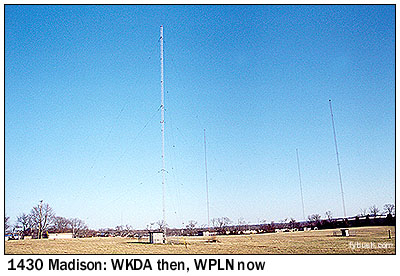 We'd just circled
the north side of Nashville, stopping at WWCR shortwave and its
AM sister, WNQM 1300, passing several big TV sites and then heading
to the 50 kW home of WLAC, that familiar signal on 1510.
We'd just circled
the north side of Nashville, stopping at WWCR shortwave and its
AM sister, WNQM 1300, passing several big TV sites and then heading
to the 50 kW home of WLAC, that familiar signal on 1510.
And that left us somewhere in the vicinity of Tennessee 45 as it crosses US 31W, I-65 and US 31E northeast of Nashville - just where we needed to be to find another interesting Music City site.
The 1430 station in Madison was still using the WKDA calls when we pulled up there, but those calls had a heritage elsewhere on the dial, having long lived at 1240 in Nashville (paired with WKDF on the FM dial at 103.3, which still lives on under separate ownership) before being pulled up the road and up the dial.
1430 was doing Spanish, simulcasting on that new 1200 that we had seen over by WNQM/WWCR - but change was in the air that March afternoon. The deal hadn't quite closed, but we knew that this signal would soon be doing public radio in the hands of "Nashville Public Radio," WPLN 90.3 FM. In any case, we found the 1430 array, four towers in a residential neighborhood off US 31E (aka Gallatin Highway), and noted that these nice folks would soon be able to hear All Things Considered very, very well.
Indeed, WKDA and WQDQ 1200 swapped calls just a few weeks later (March 26, to be exact), and in early April 1430 became WPLN and is now a second public radio outlet for Nashville.
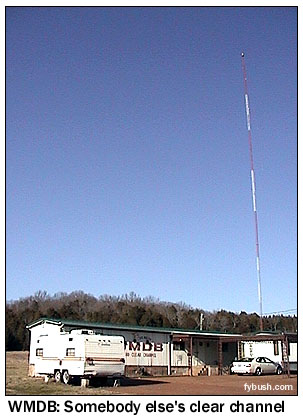
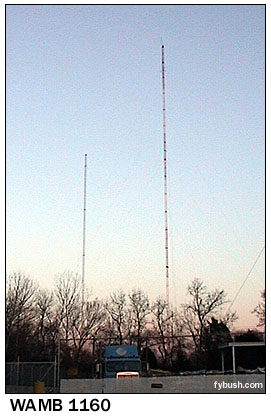 We
were off in search of more radio before sundown, though, and
we found it, beginning in an out-of-the-way part of town just
north of downtown but a world away across the Cumberland River.
That's where "Clear Channel 880" turned up: black gospel
daytimer WMDB, which promotes itself as "The Big Mouth"
from this little trailer-turned-studio next to the tower.
We
were off in search of more radio before sundown, though, and
we found it, beginning in an out-of-the-way part of town just
north of downtown but a world away across the Cumberland River.
That's where "Clear Channel 880" turned up: black gospel
daytimer WMDB, which promotes itself as "The Big Mouth"
from this little trailer-turned-studio next to the tower.
As for the "Clear Channel" part, that comes in at sunset, when WMDB turns off its 2500 watts and WCBS (or Cuba, depending on the night) rolls on in.
Speaking of Cuba, our next stop brought with it an interesting story. After detouring through the Opryland complex to glimpse the WSM studios (you saw those in our WSM installment) and checking into our hotel to set up the VCRs and such, we headed back into the city from the east side, detouring off I-40 into the industrial neighborhoods that line the south shore of the Cumberland River. That's where we came across the two towers of WAMB, the adult-standards station licensed to Donelson and operating on 1160 kHz for the last decade and a half or so.
With 50,000 watts by day, WAMB puts out a nice AM stereo signal across Nashville - but with just a kilowatt at night, the WAMB signal doesn't get out as well under the best of circumstances. And the late eighties, when WAMB signed on at 1160, were not the best of circumstances, as Cuba flexed its Cold War muscles and fired up high-powered transmitters on several channels, including 1160. So WAMB's politically-connected ownership won FCC permission for a low-powered "temporary" signal on 106.7, which survives to this day (albeit on 98.7, having endured a frequency shift when 106.7 was allocated to Belle Meade as a new class A signal.)
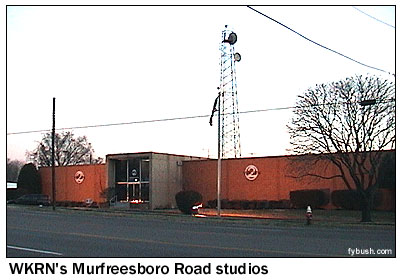 Finding our way out
to nearby Murfreesboro Road, we drive by the brick box that's
home to WKRN (Channel 2), whose channel-changing days we recounted
last week.
Finding our way out
to nearby Murfreesboro Road, we drive by the brick box that's
home to WKRN (Channel 2), whose channel-changing days we recounted
last week.
Also nearby, though skipped on account of the setting sun, is the religious college (Trevecca Nazarene) that's home to WENO (760) and WNAZ-FM (89.1). Guess what they program?
We heard WENO sign off a few minutes later, while parked next to the Citadel cluster just south of downtown Nashville. This is where WKDF (103.3) has its studios (it's doing country these days, after decades as a rocker), along with sister station WGFX (104.5); it's also the home of the Tennessee Titans radio network.
Out in the parking lot sits a newish tower that's home to aux antennas for WKDF and WGFX - and the main tower for the former WKDA, now WNSG on 1240 and programming southern gospel. If memory serves us correctly, this tower was destroyed some years ago and rebuilt on the same site - and with the same nifty view of the Nashville skyline. (These don't look like sunset shots, you say? True - we went back the next morning to see them in daylight...)
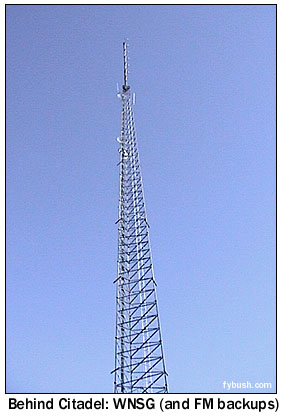
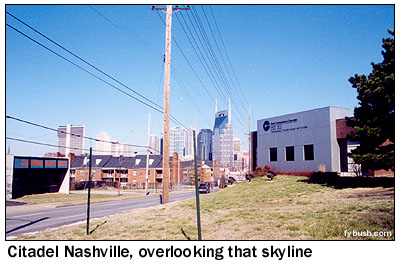
After a quick drive through downtown, we headed out for dinner at the shopping center that's replaced the now-defunct Opryland USA theme park, out by the huge Opryland hotel and theater complex that's home to WSM and the Grand Ole Opry.
The next morning, Garrett has an early flight, so your editor's on his own to finish with a few final sites before catching his own plane home...and here's how it went:
After a quick repeat visit to the Citadel complex, it was into downtown Nashville for a spin past the state capital complex, which sits on a bluff at the north end of downtown (which itself commands a bluff on a bend in the Cumberland River), then a drive down James Robertson Parkway past the studios of CBS affiliate WTVF (the old WLAC-TV). Pretty modern, huh?
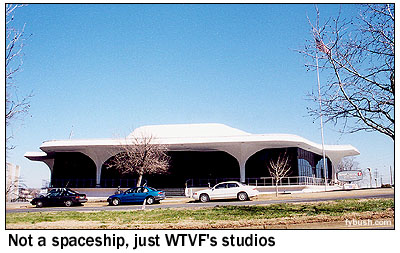 Cross the river here,
and you're in a much more suburban setting on the east bank -
not far from the single tower of yet another religious AM, WNAH
(1360). WNAH runs 1000 watts by day and drops down to just 27
at night, which might explain why we never heard it after dark.
Cross the river here,
and you're in a much more suburban setting on the east bank -
not far from the single tower of yet another religious AM, WNAH
(1360). WNAH runs 1000 watts by day and drops down to just 27
at night, which might explain why we never heard it after dark.
After a quick drive past WNAH, it was on to another nearby AM signal, this one with a surprisingly big array. WVOL (1470) is licensed not to Nashville but to Berry Hill, even though the six towers and studio building are almost within sight of downtown! (Blame the 1000-watt night signal for that; the daytime 5 kilowatts covers the city quite nicely, thanks.)
WVOL (the initials come, of course, from Tennessee's nickname of the "Volunteer State") plays R&B oldies, and good ones at that - it made for a fun listen as we crossed back over the river to see a few more final sites west of downtown along the south bank of the Cumberland.
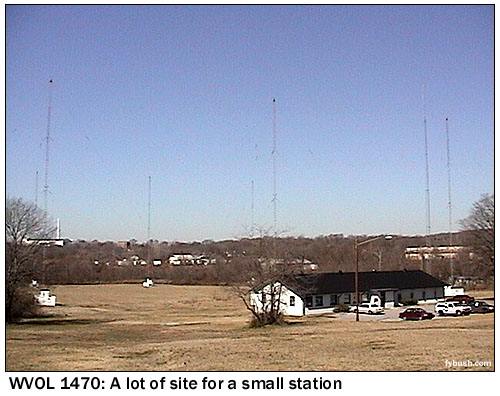
If it looks like a seven tower array in the photo above, look more closely: the stick that's in the foreground, second from right, isn't part of the 1470 array, but rather carries two-way antennas and such.


Passing back through downtown, the route went along "Music Row," the district west of downtown Nashville that's home to an enormous concentration of music publishers and clubs, not to mention a few radio stations. Clear Channel is the big presence here: its Music Row building, shown above, is home to market-dominating country station WSIX (97.9), CHR WRVW (107.5), modern rocker WNRQ (105.9, the old WLAC-FM), urban WUBT (101.1) and news-talk WLAC (1510). A few blocks away sit the studios of religious WNAH (1360).
Heading down to the vicinity of the state fairgrounds, we found Nashville Public TV, WNPT (Channel 8), in a concrete building that reminded us immensely of the old WXXI studios here in Rochester before they added an office tower next door.
 And the final stop,
in an office park along the banks of the Tennessee just west
of downtown, yielded two expected sites and a surprise.
And the final stop,
in an office park along the banks of the Tennessee just west
of downtown, yielded two expected sites and a surprise.
We knew we'd find Nashville Public Radio (WPLN 90.3) in a spiffy new building - and we knew we'd find Fox affiliate WZTV (Channel 17) and UPN affiliate WUXP (Channel 30) in a nondescript building across the street (where Sinclair now also manages WB affiliate WNAB, channel 58) - but we never expected to find the Gore/Lieberman national campaign headquarters, with sign still intact, just down the street!
And with that, it was off to the airport and back home to Rochester, with the promise that we'll head back this way someday.
- Previous Site of the Week: Nashville, Tennessee, part one
- Next Week: Droitwich and Brookmans Park, England
- How can you help support Site of the Week? Click here!
- Submit your suggestions for a future Site of the Week!
